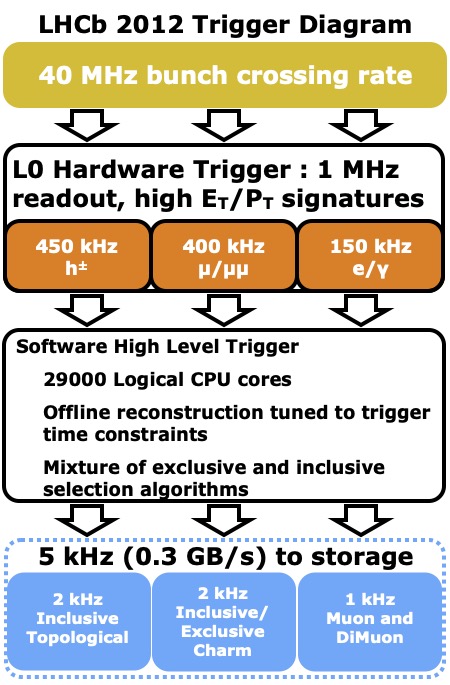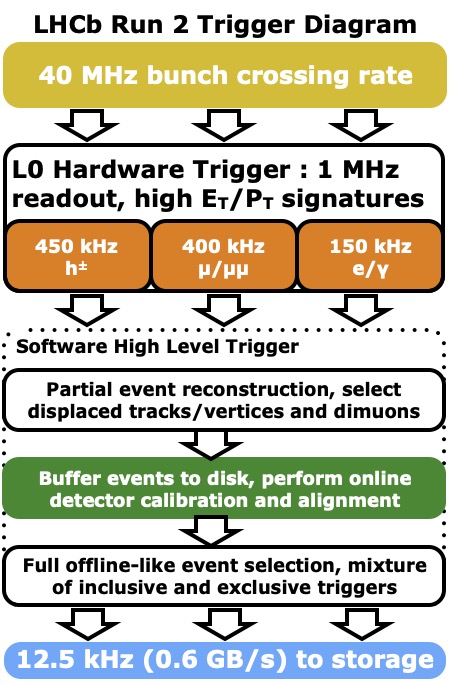Even though the frequency of bunch crossings at the interaction point inside LHCb is 40MHz, only about 25MHz of events will have some particles from the proton-proton collision inside the acceptance of the detector.
The rate of events in which a beauty or charm particle decays such that all its products are contained in LHCb corresponds to about 600 kHz. However, the rate of specific decays that are interesting for physics analysis is a small fraction of that, amounting to a total of a few hundred Hz. The event rate that can be recorded is limited by the offline computing capacity to about 10 kHz. Within this constraint the LHCb trigger aims to provide the highest efficiency for interesting signals, as well as control modes used to measure and calibrate the detector performance. It is organized in two levels.
Level Zero (L0)
The Level-0 trigger is implemented in custom electronics, and it reduces the rate to 1MHz. It makes use of the fact that particles from a B decay have a higher transverse momentum with respect to the particle beam axis (pT) than particles coming directly from the primary proton-proton interaction.
L0 makes use of those sub-detectors in which high-pT particles can be selected at the high rate required: the calorimeters and the muon system. The L0 also uses the number of hits registered in one part of LHCb’s calorimeter to measure the overall density of hits in an event. This occupancy information is subsequently used to reject especially dense events which are much more computationally complex to analyse and in which the detector reconstruction performance is degraded. In addition, it uses two dedicated silicon layers of the VELO to perform a simplified vertex reconstruction, which allows events with multiple proton-proton interactions to be rejected for certain analysis paths which cannot easily be performed with such events.
High Level Trigger (HLT)
The HLT algorithm runs in a farm of 1000 16-core computers, and it has access to full detector information. It is divided in two sub-levels: a first stage called HLT1, with an output rate of around 100 kHz, and a second stage called HLT2, which outputs the final recorded rate which gradually increased from around 2 kHz in 2010 to around 10 kHz in 2018.
The HLT1 stage is based on the use of charged particle reconstruction (tracking) to identify events which, in addition to the high transverse momentum already found at L0, also have particles whose origin is incompatible with the primary proton-proton collision in the event. This combination of high-pT and displacement from the primary collision is the tell-tale sign of the decay of longer-lived particles, such as beauty and charm hadrons, which are of principal interest for LHCb’s physics program. The main HLT1 selection from 2010 to 2018 was based on the presence of a single high-pT, highly displaced, charged particle, while an additional selection based on a pair of such particles adds sensitivity for some areas of the physics programme. In addition, information from LHCb’s muon detectors is used to identify charged particles as muons. Because muons are much rarer than other kinds of charged particles, events containing muons can be selected using looser criteria. For example two oppositely-charged muons can be selected without requiring displacement information, which allows LHCb to study the production of many short-lived resonant states which decay directly at the point of the primary collision.

At the greatly reduced rate that HLT2 is executed, it is possible to run a much more complete reconstruction of the events, including all constituent parts of the LHCb detector. This reconstruction evolved in sophistication throughout the 2010-2018 datataking period, and from 2015 onwards was equivalent to the ultimate quality detector reconstruction traditionally executed offline on events already saved to permanent storage. HLT2 employs hundreds of physics selections which aggregate the low-level information from the detector reconstruction into higher-level physics objects and signal candidates of interest to specific analyses. Two broad classes of selections are used.
The first are so-called inclusive selections which tag an event as interesting based on a general topology shared by many different signals, for example a pair of charged particles or leptons displaced from the primary collision. These selections are particularly important because they allow LHCb to develop new ideas for physics analyses even after data is taken in real-time, as long as they fit within a general topology selected by the inclusive triggers.
The second class of selections are called exclusive and select a specific fully-reconstructed decay used by a particular physics analysis. Exclusive selections are particularly important for signals which are too abundant to be selected inclusively, such as decays of hadrons containing charm quarks, but also for selecting high-statistics samples of calibration decays used to understand and measure the detector performance. Exclusive selections are performed using all available information, including the mass and vertex quality and separation for the signal candidate and any intermediate products of its decay.

Between 2013 and 2015 the HLT was upgraded with 10 Petabytes of storage to allow events selected by HLT1 to be buffered while waiting for HLT2 processing. This allowed alignment and calibration of the detector in real-time, as described here. The success of this model in 2015-2018 datataking laid the foundations for LHCb’s upgrade data collection model and enabled a greatly increased signal rate to be collected in particular for charm and other highly-abundant physics samples.
